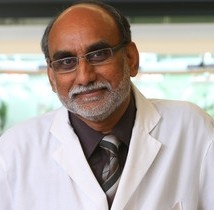
HALIFAX — A Nova Scotia professor is striving to create the ideal Christmas tree, inside the only research lab of its kind in the world.
Dalhousie University’s Raj Lada is the director of the Christmas Tree Research Centre in Truro, N.S., a unique lab dedicated to improving balsam fir Christmas trees.
“We are the pioneers in terms of what we have been doing,” said Lada, a plant, tree and ecophysiology professor in the school’s Plant, Food and Environmental Sciences Department.
The centre’s flagship product is the SMART Balsam, which epitomizes the quintessential Christmas tree: architecturally sound, fragrant and an able to retain its blue-green needles for up to three months.
Lada said solving industry-wide challenges, such as needle retention, is critical to the survival of the multimillion-dollar Christmas tree industry in Atlantic Canada, as it competes with other markets and artificial trees.
His interest in Christmas trees was sparked more than a decade ago, when a producer approached him after he was not paid for a shipment to British Columbia because of needle loss.
“I could see it in his eyes,” he said. “The trees had lost needles, but it looked like he had lost his life, like he had lost his business, his credibility.”
He began looking into the plight of the producer, researching shipping processes and other factors that affecting the trees during transport.
Lada then went to the Christmas Tree Council of Nova Scotia.
“It seemed this had been a common problem all these years,” he said.
At the time, there had been no research on the physiology of post-harvest needle loss in balsam fir trees. And so, Lada took it on as his personal mission.
He brought together producers from across eastern Canada to form the Atlantic Christmas Tree Research and Development Consortium, and they devised research priorities.
The producers’ No. 1 concern: needle retention.
Eventually, Lada received a grant from Ottawa’s Atlantic Canada Opportunity Agency.
Among his latest research projects is the SMART tree, which Lada believes will revolutionize the Christmas tree industry.
Lada and his team started by screening balsam firs for ideal traits, including fullness and the ability to retain needles. Genetic markers for those traits were identified.
SMART trees are now being mass produced for market.
Lada expects planting to start next year.
“They’ll look great, smell great, and they’ll also have a higher needle retention capacity,” said Lada. “Nothing will beat the SMART trees.”
The centre has also developed and licensed needle-loss prevention agents, which are applied with water.
As well, Lada’s team has created technologies for shipping and storage that can help Christmas trees remain fresh for at least two months.
Lada’s partners include provincial government departments in Nova Scotia, New Brunswick and Newfoundland and Labrador.
“This has not being done in such a co-ordinated, consorted way in the past,” he said. “The industry has been managing the situation, but now we have solutions for it.”